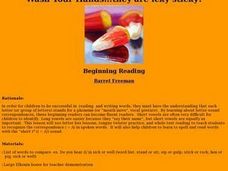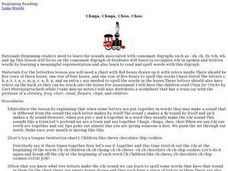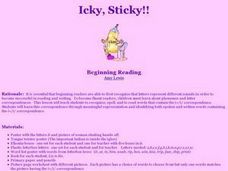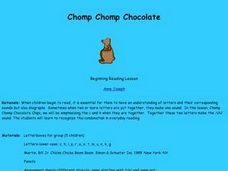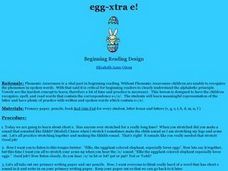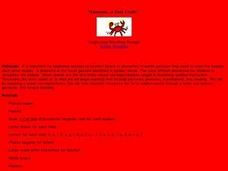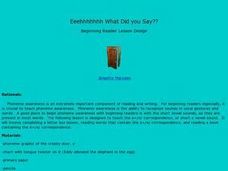Curated OER
Icky Sticky Tin Man
Learners recognize the short vowel i in written and spoken language. Through listening and matching activities, they discriminate the vowel sound /i/ from other phonemes. Students associate the phoneme with its letter representation and...
Curated OER
O No!
First graders distinguish between short vowel a and long vowel O. They are introduced to the vowel-consonant-e pattern that changes short vowel sounds into long vowel sounds. They practice spelling words with the vowel-consonant-e pattern.
Curated OER
Wash Your Hands...they are icky sticky!
Learners engage in an emergent literacy lesson that focuses on phonemic awareness and they practice corresponding the letter "i" to its long or short sound. This type of recognition has been found to be essential to reading development.
Curated OER
Alphabet Review
For this alphabet worksheet, students name letters, say the sounds for sets of letters, and practice reading simple sentences.
Curated OER
Opera Singer
Students recognize the short vowel o in written and spoken language. Through listening and decoding activities, they discriminate the vowel sound /o/ from other phonemes. Students identify the phoneme and letter in pseudo words they read.
Curated OER
Chuga Chuga Choo Choo
First graders identify the digraph /ch/ in written and spoken language. After a brief discussion of the independent and combined sounds of the phonemes /c/ and /h/ students practice identifying initial and final placement of the new...
Curated OER
Choo Choo Train
First graders study the sound and spelling of the /ch/ digraph. They repeat words containing the "ch" before making words using their Elkonin letterboxes and letter manipulatives. Next, they clap each time they hear the "ch" digraph...
Curated OER
Icky Sticky and Itty Bitty
Pupils identify the letter i and the sound that it makes in various words and illustrations with the sound /i/. They practice writing the letter I both upper and lower case on paper. Finally, students circle the pictures with the /i/...
Curated OER
Icky-Sticky
Pupils practice recognizing the connection between phonemes and letters with an emphasis on finding the short vowel /i/ in words. They each receive a Elkonin letterbox and a picture card with icky-sticky gum on it and the letter i.
Curated OER
O-o-o-oh, no-o-o-o!!
Students engage in an emergent literacy lesson in order to practice the skill of phonemic awareness. They learn this skill using the phoneme for the letter "o". Students must recognize the letter as well as its sound.
Curated OER
Chomp Chomp Chocolate
Students identify the digraph /ch/ in written and spoken language. Students practice identifying the initial and final placement of the digraph /ch/ in words by identifying pictures containing the sound. They read a decodable story...
Curated OER
Chug Choo Choo
First graders identify the digraph /ch/ in written and spoken language. After a brief discussion of the independent and combined sounds of the phonemes /c/ and /h/ students practice identifying initial and final placement of the new...
Curated OER
Ew!!! It's Icky Sticky!
Students engage in an emergent literacy lesson that focuses upon the skill of phonemic awareness. The phoneme sound for the letter "i" is used with a tongue twister to build this important reading skill.
Curated OER
Chocolate Chicken
Students identify digraphs in written and spoken language. After a brief discussion on the combinations of letters that comprise digraphs, students practice identifying initial and final placement of the digraph /ch/ in words and tongue...
Curated OER
E-E-E-E-Extra E-E-E-E-Effort
Pupils listen to a tongue twister emphasizing the short e sound. They practice writing the letter e and attaching different words with that sound to it. They listen to a book about a dog that enhances the letter e. They write a...
Curated OER
Egg-xtra E!
First graders recognize the short vowel e in written and spoken language. Through listening activities, they discriminate the vowel sound /e/ from other phonemes. Students identify the phoneme and letter in words and sentences they write.
Curated OER
Icky Fingers
Learners are introduced to digraphs so they can match letters to their phonemes. They recognize the short vowel i=/i/ in both spoken and written words by practicing reading and spelling words containing /i/. Elkonin Letter Boxes are...
Curated OER
"Aaaaaaa...a Fast Crab! "
Students participate in an emergent literacy lesson that focuses on the skill of phonemic awareness. The phoneme chosen is the letter "a". They need to correlate the sound to the letter.
Curated OER
Shiny Shells on the Shore
Students investigate how: A single phoneme, which is a vocal gesture in spoken words, can be represented by more than one grapheme. Also how a digraph is the combination of two letters that make one sound (there are both vowel and...
Curated OER
Eeehhhhhhh What Did you Say??
Student read pseudo words containing the e=/e/ correspondence and recognize sounds in vocal gestures and words. They explore the e=/e/ correspondence, or short e vowel sound and complete a letter box lesson, reading words that contain...
Curated OER
Choo, Choo, words that say /Ch/!
Students identify the digraph /ch/ in written and spoken language. After a brief discussion of the independent and combined sounds of the phonemes /c/ and /h/ students practice identifying initial and final placement of the new digraph...
Curated OER
The Squeaky Creaky Elevator
Young scholars engage in an emergent literacy lesson in order to help develop the skills of letter recognition and corresponding sound of the phoneme. This is done with the use of a tongue twister using the phoneme of the letter "e".
Curated OER
U-u-under The U-u-umbrella!
Students practice using phonemes because they need to be able to recognize that phonemes and letters correspond with each other in order to become a proficient reader. The practice is done using the letter "u".
Curated OER
I Feel the Need....The Need for Speed!
Students first learn to decode when learning to read. Decoding each letter and phoneme in a sentence or even a short text takes a considerable amount of time. Students must drill to progress in the pace and level of their reading. In...


